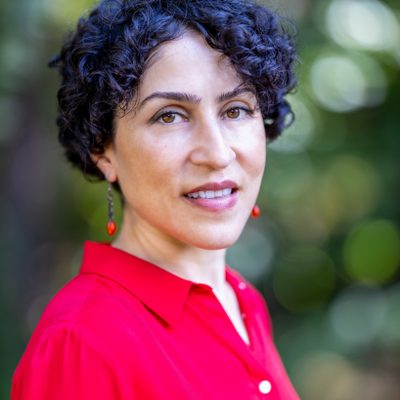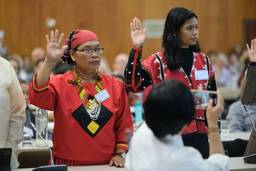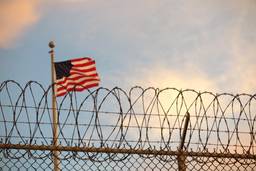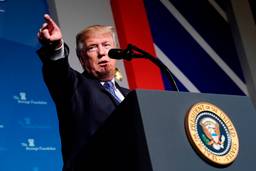If We Want to Support Refugees, We Need To End the Wars That Create Them
The sanctuary movement needs an anti-war voice.
Azadeh Shahshahani and Maha Hilal
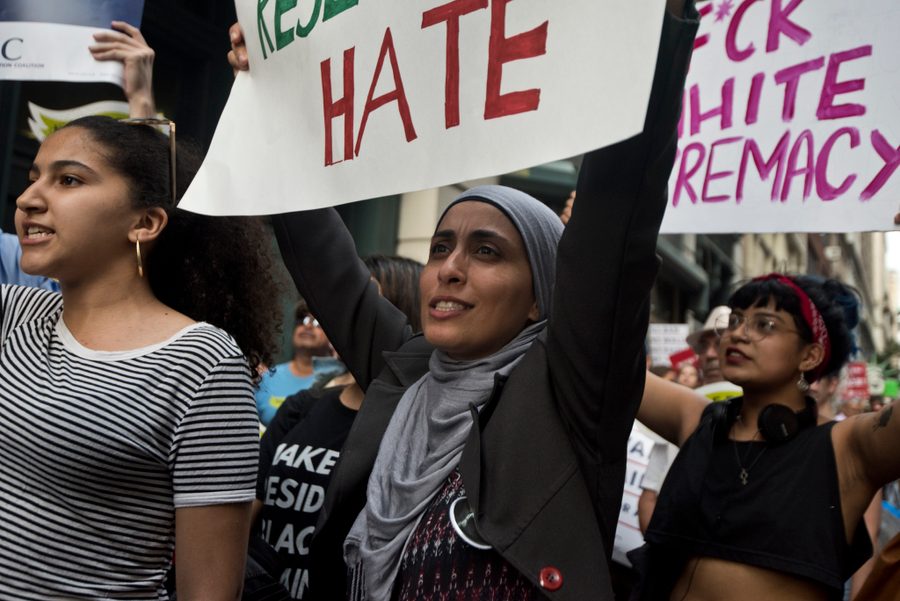
This article was produced in partnership with Foreign Policy In Focus.
The concept of sanctuary, providing refuge and protection to people who are marginalized and oppressed, has a long history in the United States — even when the United States itself is responsible for that repression.
An early example of sanctuary in the United States is the Underground Railroad of the 19th century, which helped people escape slavery through routes and houses identified as safe by abolitionists and freedom seekers. In the 1950s and 60s, African-American organizers of the civil rights movement often held meetings in churches. Immigrant justice advocates have pioneered “sanctuary churches” since the 1980s.
These days, the concept is most often associated with so-called “sanctuary cities” — state and local jurisdictions that say they refuse to cooperate with federal efforts to deport undocumented residents. These cities have been relentlessly targeted by the Trump administration.
Meanwhile, through three iterations of the Muslim Ban and other policies, Trump has drastically cut the number of refugees accepted into the United States from other countries.
The administration’s aggression has reignited movements to challenge anti-immigrant policies and defend the rights and safety of immigrants. Successful legal challenges have been lodged against an anti-sanctuary city order, for example, while other challenges initially delayed the full implementation of the Muslim Ban. Still, none of that fightback has deterred the administration from its war on sanctuary, or on immigrant communities more generally.
Troublingly, the U.S. foreign policies that displace people from other countries remain firmly in place. And here, there’s a lot of room for the sanctuary movement to grow.
With the administration creating such a hostile atmosphere, the role of sanctuary to protect vulnerable communities has become even more critical. But in the long term, sanctuary has to mean more than just providing refuge, or filing legal briefs on behalf of the displaced, though these services are vital.
Ultimately, with sanctuary should come a renewed commitment to challenging the U.S. foreign policies that actually displace people.
The revival of the sanctuary movement
The modern sanctuary movement evolved in the 1980s in response to the heavy hand of U.S. policies in Latin America — a history detailed extensively in a 2006 Migration Policy Institute paper by Susan Gzesh.
The right wing was on the rise then, and so was the Cold War.
In the late 1970s and 80s, El Salvador and Guatemala became embroiled in civil wars. Rather than supporting democracy, the United States intervened to help vicious right-wing governments suppress Marxist-led popular movements there.
In El Salvador, Gzesh writes, U.S. forces aided Salvadoran military forces and paramilitary death squads that “were responsible for thousands of disappearances and murders of union leaders, community leaders, and suspected guerilla sympathizers, including priests and nuns.” Next door in Guatemala, the country’s U.S.-backed army waged a genocidal counter-insurgency campaign against indigenous communities.
The result of these policies was a massive refugee flow. Ultimately, nearly a million Salvadorans and Guatemalans fled to the United States.
Despite the fact that they were fleeing repressive governments backed by the United States, these displaced people were treated as “economic migrants,” and consequently denied their status as refugees or asylum seekers. Because of this designation, Gzesh notes, approval rates for Salvadoran and Guatemalan asylum cases fell to under 3 percent in 1984—compared to 60 percent for Iranians, 40 percent for Afghans and 32 percent for Poles.
This gross discrimination led to a political response, as well as grassroots resistance.
In 1983, some members of Congress advocated for “Extended Voluntary Departure” for Salvadorans fleeing unrest at home. However, this request was denied, as the Reagan administration claimed approving it would only cause a larger influx of Salvadoran refugees seeking to come to the United States. Despite attempts by the House of Representatives to pass bills shielding Salvadorans from deportation, none succeeded in the Senate.
Unfazed by these political setbacks, the sanctuary movement in this era pushed immigration justice forward and broke new ground through the coordination of a broad array of grassroots movements. It was galvanized, in part, by religious congregations in places like Tucson, Arizona, and by religious leaders like the Rev. John Fife, who declared his Southside Presbyterian Church a place of sanctuary for migrants. The mid 1980’s saw the evolution of a strong sanctuary movement that included more than 540 religious congregations that publicly supported sanctuary.
Importantly, these congregations were joined by many human rights and anti-war groups — who, Gzesh says, sought to turn the debate over sanctuary into a broader “indictment of the Reagan administration’s war in Central America.”
At the same time, Salvadoran and Guatemalan refugees were developing internal mechanisms and organizations to help members of their own communities gain the assistance that they so desperately needed. These organizations included Casa Guatemala, Casa El Salvador, Comite en Solidaridad con el Pueblo de El Salvador and others.
Meanwhile, legal services projects were launched by attorneys and other activists to provide assistance to detained refugees. These efforts expanded with lawyers from nonprofits offering legal services, and private practitioners acting as legal counsel for refugees. During this time, local and national bar associations and the National Lawyers Guild National Immigration Project helped address the growing need for legal assistance.
Amid the increasing political momentum, a class-action suit called American Baptist Churches v. Thornburgh was brought forward to challenge the Reagan administration’s policies, which until that point not only categorically rejected political asylum claims, but also criminalized those who had assisted refugees gain asylum.
1991 brought a legal victory in the U.S. District Court in San Francisco — in the form of a settlement that not only allowed political asylum cases once denied to be re-opened, but also allowed for other refugees who feared the political climate the chance to apply. This decision allowed class members to obtain work permits, while also protecting them from deportation.
Importantly, Gzesh recounts, the settlement also “included language stating that government decisions on political asylum cases would not be influenced by foreign policy considerations.” That was a huge victory.
The movement eventually scored victories in Congress as well. In 1990, after its earlier failed attempts to address the situation of Central American asylum seekers, legislation was passed giving the president authority to selectively grant Temporary Protected Status. In its first iteration, TPS was extended to Salvadorans.
Violence at Home and Abroad
The sanctuary movement of the 1980s was a tremendous show of solidarity with Salvadorans and Guatemalans fleeing repressive, U.S.-backed regimes. The movement operated as an integral part of the anti-war and solidarity movement opposing U.S. involvement in the Central American wars.
While the movement scored important victories in protecting refugees, the underlying U.S. foreign policies that contributed to their displacement did enormous damage in Latin America and beyond — then and now.
For decades, the United States has trained members of the region’s militaries in the arts of torture and intimidation, impeded democracy by supporting a variety of dictatorships, and tampered in elections—right on up to the recent election in Honduras. There, the U.S.-trained forces of a right-wing government have brutally cracked down on protesters who, backed by international observers, say the vote was fraudulent. Meanwhile, mass U.S. deportations of gang members and gun exports and — in the case of Honduras — support for a coup government have helped make El Salvador, Guatemala and Honduras three of the deadliest countries on earth.
Despite inflicting this damage, the United States recently pulled back on humanitarian relief measures such as Temporary Protected Status for Salvadorans, threatening 200,000 people with deportation. Moreover, Trump has repeatedly (and infamously) called for a border wall between the United States and Mexico, where decades of U.S. trade policy and drug war intervention have also caused tremendous violence and displacement.
Today, sanctuary cities and places of worship have re-emerged as a powerful force challenging Trump’s aggressions against immigrants not only from Latin America, but also from other countries. A movement starting as far back as the airport protests against the first Muslim Ban has fought back against the administration’s cruelty to immigrants and refugees from the Muslim world.
There too, displacement and forced migration have been widespread as a result of U.S. intervention. The United States, of course, has launched wars in both Afghanistan and Iraq — with the war in Afghanistan being the longest official war yet—now indefinitely extended by the Trump administration. The United States has also been deeply involved in wars in Libya, Syria and beyond.
The Costs of War project estimates that 76 countries are now part of Washington’s “War on Terror”—many of which were named in various iterations of Trump’s Muslim Ban. In effect, the administration is once again trying to ban migrants from the very countries where the United States is dropping bombs, selling arms, supporting dictators or otherwise contributing to instability and repression.
In an inspiring show of solidarity, airport rallies and subsequent mobilizations opened their arms to immigrants and refugees from the Muslim world. But in something of a contrast with the movements of the 1980s, which directly connected the refugee crisis to U.S.-backed wars in Latin America, fewer contemporary voices have raised questions about why refugees might have left their countries, or what role U.S. violence might’ve played in displacing them.
“Generosity” is only a start
Securing refuge for vulnerable people is of course central to the work of protecting refugees and immigrants. But that work would be significantly strengthened by movements broadening their focus to include demands for ending the wars and accountability for U.S. policies that create refugee flows.
Otherwise, refugee resettlement is cast in terms of generosity, like a favor the United States does for the impoverished.
For example, the U.S. State Department’s website states: “The United States is proud of its history of welcoming immigrants and refugees. The U.S. refugee resettlement program reflects the United States’ highest values and aspirations to compassion, generosity, and leadership.”
While this framing might be useful for persuading some otherwise unwilling people to embrace immigrants and refugees, it fails to mention the U.S. role in bombing people’s homes, arming rebel groups or otherwise intervening in violent conflicts — among other acts that create refugees.
Even before Trump, when people more sympathetic to refugees had the ear of the White House, the United States was making appeals for refugees on the one hand while creating them with the other.
For example, President Obama announced in September 2016 that the U.S. would take more than 110,000 refugees, including an increased number from Syria, calling the refugee crisis a “test of our common humanity.” Though the next administration put a quick end to that goal, this was a welcome gesture at the time, considering that the U.S. has accepted only a tiny percentage of the millions of refugees created by the war.
But more significantly, the United States dropped more than 12,000 bombs on Syria in 2016 alone — all under Obama’s watch — which only exacerbated the refugee crisis. “Generosity” can mitigate some of this harm, but it’s not enough on its own.
Making the Connections
If we’re serious about supporting refugees, we need to be serious about ending the wars that create them. As the sanctuary movement expands, the need to incorporate an anti-war and anti-militarist lens could not be more important.
Specifically, that means advocating for an immediate end to wars in Afghanistan and the Middle East, demanding that military spending be used instead on social services and infrastructure needs in the United States, and supporting local resolutions that support refugees and immigrants and call for changes in U.S. foreign policy.
What if the United States actually owned up to its violence? How much more compelling would the movement call to protect those who come to our borders be, if people understand that they’re fleeing violence that the United States has caused?
The United States has always been a country of ideals — despite never living up to them. The rise of sanctuary movements is a new chance to push for the realization of these ideals by telling real stories about cause and effect. It’s a chance to build a multi-pronged movement aimed at protecting refugees and ending the wars that turn people into refugees.
The first step is making the connections.
Azadeh Shahshahani is legal and advocacy director at Project South and a past president of the National Lawyers Guild. She tweets @ashshahahani and you can read her work at In These Times here.
